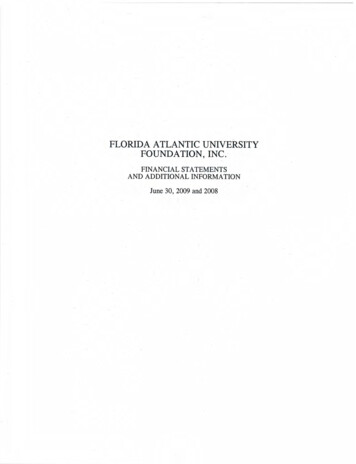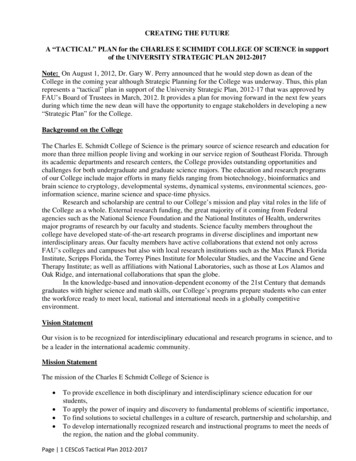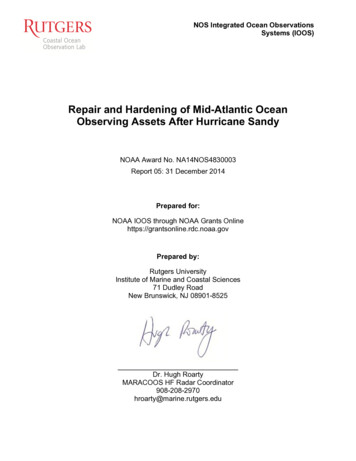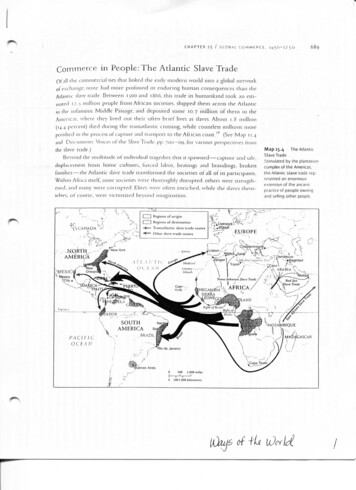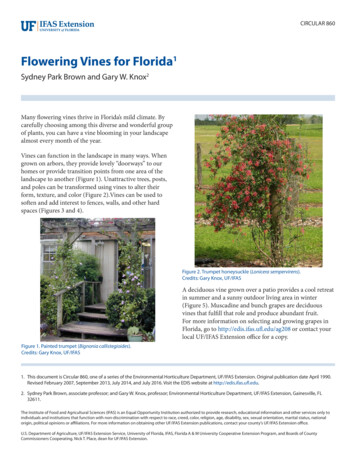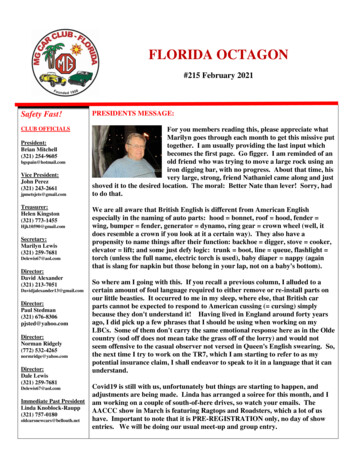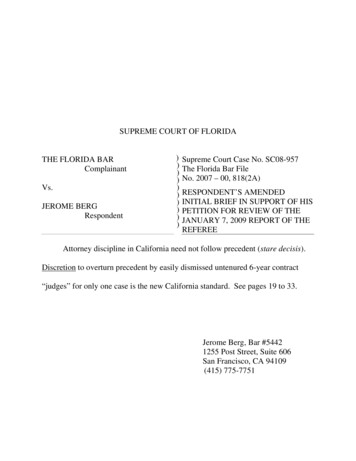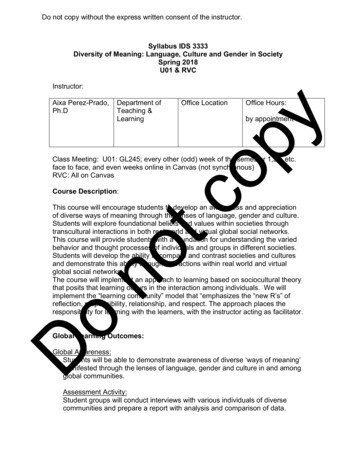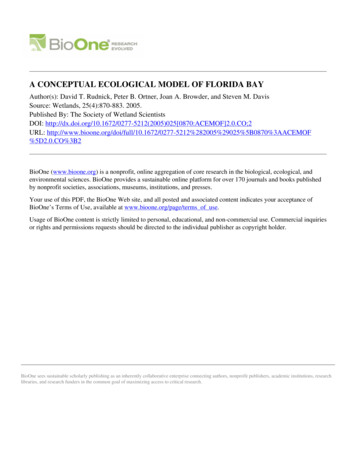
Transcription
A CONCEPTUAL ECOLOGICAL MODEL OF FLORIDA BAYAuthor(s): David T. Rudnick, Peter B. Ortner, Joan A. Browder, and Steven M. DavisSource: Wetlands, 25(4):870-883. 2005.Published By: The Society of Wetland ScientistsDOI: ACEMOF]2.0.CO;2URL: 82005%29025%5B0870%3AACEMOF%5D2.0.CO%3B2BioOne (www.bioone.org) is a nonprofit, online aggregation of core research in the biological, ecological, andenvironmental sciences. BioOne provides a sustainable online platform for over 170 journals and books publishedby nonprofit societies, associations, museums, institutions, and presses.Your use of this PDF, the BioOne Web site, and all posted and associated content indicates your acceptance ofBioOne’s Terms of Use, available at www.bioone.org/page/terms of use.Usage of BioOne content is strictly limited to personal, educational, and non-commercial use. Commercial inquiriesor rights and permissions requests should be directed to the individual publisher as copyright holder.BioOne sees sustainable scholarly publishing as an inherently collaborative enterprise connecting authors, nonprofit publishers, academic institutions, researchlibraries, and research funders in the common goal of maximizing access to critical research.
WETLANDS, Vol. 25, No. 4, December 2005, pp. 870–883q 2005, The Society of Wetland ScientistsA CONCEPTUAL ECOLOGICAL MODEL OF FLORIDA BAYDavid T. Rudnick1, Peter B. Ortner2, Joan A. Browder3, and Steven M. Davis41Coastal Ecosystems DivisionSouth Florida Water Management District3301 Gun Club RoadWest Palm Beach, Florida, USA 33406E-mail: drudnic@sfwmd.gov2Atlantic Oceanographic and Meteorological LaboratoryNational Oceanic and Atmospheric Administration4301 Rickenbacker CausewayMiami, Florida, USA 33149Southeast Fisheries Science CenterNational Marine Fisheries ServiceNational Oceanic and Atmospheric Administration75 Virginia Beach DriveMiami, Florida, USA 331493RECOVER SectionSouth Florida Water Management District3301 Gun Club RoadWest Palm Beach, Florida, USA 334064Abstract: Florida Bay is a large and shallow estuary that is linked to the Everglades watershed and is atarget of the Greater Everglades ecosystem restoration effort. The conceptual ecological model presentedhere is a qualitative and minimal depiction of those ecosystem components and linkages that are consideredessential for understanding historic changes in the bay ecosystem, the role of human activities as drivers ofthese changes, and how restoration efforts are likely to affect the ecosystem in the future. The conceptualmodel serves as a guide for monitoring and research within an adaptive management framework. Historicchanges in Florida Bay that are of primary concern are the occurrence of seagrass mass mortality andsubsequent phytoplankton blooms in the 1980s and 1990s. These changes are hypothesized to have beencaused by long-term changes in the salinity regime of the bay that were driven by water management.However, historic ecological changes also may have been influenced by other human activities, includingocclusion of passes between the Florida Keys and increased nutrient loading. The key to Florida Bay restoration is hypothesized to be seagrass community restoration. This community is the central ecosystemelement, providing habitat for upper trophic level species and strongly influencing productivity patterns,sediment resuspension, light penetration, nutrient availability, and phytoplankton dynamics. An expectationof Everglades restoration is that changing patterns of freshwater flow toward more natural patterns will driveFlorida Bay’s structure and function toward its pre-drainage condition. However, considerable uncertaintyexists regarding the indirect effects of changing freshwater flow, particularly with regard to the potential forchanging the export of dissolved organic matter from the Everglades and the fate and effects of this nutrientsource. Adaptive management of Florida Bay, as an integral part of Everglades restoration, requires anintegrated program of monitoring, research to decrease uncertainties, and development of quantitative models(especially hydrodynamic and water quality) to synthesize data, develop and test hypotheses, and improvepredictive capabilities. Understanding and quantitatively predicting changes in the nature of watershed-estuarine linkages is the highest priority scientific need for Florida Bay restoration.Key Words: ecosystem restoration, estuaries, Florida Bay, Everglades, adaptive management, seagrass,freshwater flow, salinity effects870
Rudnick et al., FLORIDA BAY CONCEPTUAL ECOLOGICAL MODELBACKGROUNDFlorida Bay is a triangularly shaped estuary, withan area of about 2200 km2 that lies between the southern tip of the Florida mainland and the Florida Keys(Figure 1). About 80% of this estuary is within theboundaries of Everglades National Park and much ofthe remainder is within the Florida Keys National Marine Sanctuary. A defining feature of the bay is itsshallow depth, which averages about 1 m (Schomerand Drew 1982). Light sufficient to support photosynthesis can reach the sediment surface in almost all areas of the bay, resulting in dominance of seagrass bedsas both a habitat and a source of primary production.The shallowness of Florida Bay also affects its circulation and salinity regime. Except for basins near thenorthern coast (near freshwater sources), the bay’s water column is vertically well-mixed and usually isohaline. In contrast, its complex network of shallowmud banks restricts horizontal water exchange amongthe bay’s basins and between these basins and the Gulfof Mexico (Smith 1994, Wang et al. 1994). In areaswith long residence times, the salinity of Florida Baywater can rise rapidly during drought periods due toexcess of evaporation over precipitation and freshwater inflow (Nuttle et al. 2000). Salinity levels as highas twice that of seawater have been measured (McIvoret al. 1994). Another defining feature of the bay is thatits sediments are primarily composed of carbonatemud, which can scavenge inorganic phosphorus frombay waters (DeKanel and Morse 1978).Until the 1980s, Florida Bay was perceived by thepublic and environmental managers as being a healthyand stable system, with clear water, lush seagrass beds,and highly productive fish and shrimp populations. Inthe mid-1980s, however, catches of pink shrimp decreased dramatically (Browder et al. 1999), and in1987, a mass mortality of turtle grass (Thalassia testudinum Banks & Soland ex. Koenig) beds began(Robblee et al. 1991). By 1992, the ecosystem appeared to change from a clear water system, dominatedby benthic primary production, to a turbid water system, with algae blooms and resuspended sediments inthe water column. The conceptual ecological modelpresented here focuses on these changes in seagrasscommunities and water quality as central issues to beconsidered by environmental managers.The Florida Bay Conceptual Ecological Model isone of eleven regional models that are being used astools for synthesis, planning, assessment, and communication within the adaptive management framework of the Everglades Restoration Plan. This framework and a summary of all of the conceptual ecological models are described in Ogden et al. (2005). Overviews of the history and challenges of Everglades871restoration are presented in Ogden et al. (2005) andSklar et al. (2005). The format and symbols of theFlorida Bay model follows that of Ogden et al. (2005)and the other conceptual models published in this issueof Wetlands. Furthermore, the organization of this paper follows the conceptual model diagram, with majorsections on drivers and stressors, and ecological attributes (generally structural components of the ecosystem) and their links to stressors. A final section considers expectations and uncertainties regarding futureresponses to restoration efforts.This simple model does not address spatial complexity in Florida Bay. Florida Bay is, indeed, not somuch a singular estuary, but a complex array of morethan forty basins, with distinct characteristics, that arepartitioned by a network of mud banks and islands(Schomer and Drew 1982, Fourqurean and Robblee1999). The structure of vegetative habitats, as well aswater quality and ecosystem processes, vary distinctlywith this spatial variation. Nevertheless, only a single,generic model is described and intended to summarizethe main characteristics and trends of the bay. Whilethe structure of this model is appropriate for most areasof the bay, the relative importance of model components differ considerably among subregions. Any application of this model (e.g., recommendations for aspecific set of monitoring parameters and guidelines)must accommodate the degree of spatial variability ofthe bay.EXTERNAL DRIVERS AND ECOLOGICALSTRESSORSFollowing observations of Florida Bay’s dramaticecological changes in the 1980s, it was commonly assumed that a direct cause of these changes was a longterm increase in salinity, which in turn was caused bythe diversion of freshwater away from Florida Bay viaSouth Florida Water Management District canals.However, subsequent research has indicated that theseecological changes may not be attributable to a singlecause. While decreased freshwater inflow and resultantincreased salinity have been part of the problem, itappears that other human activities, as well as naturalforces, may have also played a role (Boesch et al.1993, Armentano et al. 1997, Fourqurean and Robblee1999). The conceptual ecological model presentedhere includes both natural and anthropogenic sourcesof stress (Figure 2). The discussion of external driversand ecological stressors below is organized by stressor(ovals in Figure 2), with consideration of the maindrivers (rectangles in Figure 2) that influence eachstressor.
872WETLANDS, Volume 25, No. 4, 2005Figure 1.Geographic setting and boundary of the Florida Bay Conceptual Ecological Model (CEM).
Rudnick et al., FLORIDA BAY CONCEPTUAL ECOLOGICAL MODEL873Figure 2. Florida Bay Conceptual Ecological Model Diagram. The format of this figure follows Ogden et al. (2005). Rectangles represent major external drivers of ecological change, ovals represent ecological stressors, diamonds represent ecologicallinkages and functions that mediate the effect of stressors on attributes, and hexagons represent ecosystem attributes to bemonitored as part of the adaptive assessment process. Increases or decreases noted in diamonds with ‘‘, Ruppia and Halodule’’and ‘‘. Nitrogen and Phosphorus’’ refer to pre-restoration changes.Altered Salinity RegimeFlorida Bay’s salinity regime varies greatly overtime and space. This variation ranges from coastal areas that can be nearly fresh during the wet season, tolarge areas of the central bay that can have salinitylevels near 70 psu during prolonged droughts, to nearly stable marine conditions (about 35 psu) on the western boundary of the bay or near Florida Keys’ passes.The main factors that determine the salinity regime inthe bay are the inflow of freshwater from the Everglades, the difference between rainfall and evaporationover the bay, and exchange with marine waters of theGulf of Mexico and Atlantic Ocean. Both freshwaterinflow and exchange with the Atlantic have changeddrastically in the past hundred years, resulting in analteration of the bay’s salinity regime (Swart et al.1999, Brewster-Wingard et al. 2001, Dwyer and Cronin 2001).Freshwater inflow to Florida Bay decreased in volume and changed in timing and distribution during thetwentieth century because of water management. Hydrologic alteration began in the late 1800s but accelerated with construction of drainage canals by 1920,the Tamiami Trail by 1930, and the Central and SouthFlorida (C&SF) Project and the South Dade Conveyance System from the early 1950s through 1980 (Lightand Dineen 1994). With diversion of freshwater to theAtlantic and Gulf of Mexico coasts to the north, thebay’s mean salinity inevitably increased. Isotopic studies of carbonate preserved in coral skeletons and bur-
874ied ostracod shells confirmed this trend (Swart et al.1999, Dwyer and Cronin 2001). Paleoecological studies also indicated that salinity variability within thebay also changed during the twentieth century, withan increase in variability in the northeastern bay,where freshwater inflows are channelized (BrewsterWingard et al. 2001), and a decrease in variability inthe southern bay (Swart et al. 1999).Paleoecological studies indicated that a cause of salinity changes in the southern bay was construction ofthe Flagler Railway across the Florida Keys from 1905to 1912 (Swart et al. 1996, 1999). In the nineteenthcentury, prior to railway construction and water management, southern Florida Bay had a lower mean salinity and more frequent periods of low (10 psu220psu) salinity than during the twentieth century. Theextent and frequency of high salinity events in thesouthern bay does not appear to have changed betweencenturies. The bay’s salinity regime changed abruptlyaround 1910 because passes between the Keys werefilled to support the railway. Thus, water exchange between Florida Bay and the Atlantic Ocean was decreased, and this probably caused an increase in waterresidence time and a change in water circulation patterns within the bay.Two important natural controls of salinity, sea-levelrise and the frequency of major hurricanes, must alsobe considered. Florida Bay is a very young estuary,the product of sea level rising over the shallow slopeof the Everglades during the past 4,000 years (Wanlesset al. 1994). With rising sea level, the bay not onlybecame larger but also became deeper. With greaterdepth, exchange of water between the ocean and thebay increased. All else being equal, this would resultin a more stable salinity regime with salinity levelsincreasingly similar to the ocean. However, a factorthat has counteracted rising sea level is accumulationof sediment, which makes the bay shallower. Mostsediment that accumulates in Florida Bay is carbonateprecipitated from water by organisms living in the bay(Bosence 1989). The extent to which these sedimentsaccumulate is a function of the biology of these organisms (including skeletal carbonate production),chemical dynamics in the water column and sediments,and the physical energy available to transport some ofthese sediments from the bay. Major hurricanes arethought to be important high-energy events that canflush the bay of accumulated sediments. However,since 1965, no major hurricane has directly affectedFlorida Bay. Resultant sediment accumulation, withassociated alteration of depth, circulation patterns, residence time, salinity, and nutrient storage may haveinfluenced ecological changes in recent decades.WETLANDS, Volume 25, No. 4, 2005Nitrogen and Phosphorus InputsProductivity and food-web structure in all ecosystems are strongly influenced by internal nutrient cycling and import and export of these nutrients.Throughout the world, estuarine ecosystems have undergone dramatic ecological changes because theyhave been markedly enriched by nutrients derivedfrom human activity (National Research Council2000). These changes have often been catastrophic,with loss of seagrasses, increased algal blooms, andincreased incidence of hypoxic and anoxic events.Augmentation of nitrogen and phosphorus inputs to anestuary is a potentially important stressor.The degree to which nitrogen and phosphorus inputshave stressed Florida Bay is unclear. In general, thebay is relatively rich in nitrogen and poor in phosphorus, especially towards the eastern region of the bay(Boyer et al. 1997). This spatial pattern is at least partly a function of natural biogeochemical processes (e.g.,P retention by the bay’s carbonate sediments and relatively low N in adjacent marine waters) and thus mayhave existed prior to recent human influences. Littledirect evidence confirms that nutrient inputs to the bayor concentrations within the bay have increased duringthe past century, but with expanding agricultural andresidential development in South Florida, and particularly development of the Florida Keys, some nutrientenrichment almost certainly has occurred (Lapointeand Clark 1992, Orem et al. 1999). Anthropogenic nutrients that enter Florida Bay are derived not only fromlocal sources (fertilizers and other wastes from agricultural and residential areas), but also from remotesources. Contributions of nutrients from atmosphericdeposition and from the Gulf of Mexico, which mayinclude nutrients from the phosphate fertilizer industryof the Tampa-Port Charlotte area and residential development from Tampa to Naples, are significant external nutrient sources (Rudnick et al. 1999).Different sub-regions of the bay are differentiallyinfluenced by these local or remote sources, dependingon the magnitude of inputs, relative abundance of different nutrients, internal cycling pathways and rates,and water residence time (Boyer et al. 1997, Rudnicket al. 1999, Childers et al. 2005). Algal bloom occurrence in the central and western bay is influenced bya combination of these factors (Tomas et al. 1999,Brand 2002). Despite the lack of definitive data, it is,nevertheless, a reasonable hypothesis that a chronicincrease in nutrient inputs occurred in Florida Bay inthe twentieth century and that this increase contributedto the bay’s recent ecological changes. Developmentof a water quality model driven by appropriatelyscaled hydrodynamic and hydrologic models is essential to understand and evaluate quantitatively the po-
Rudnick et al., FLORIDA BAY CONCEPTUAL ECOLOGICAL MODELtential effects of past nutrient inputs and predict theeffects of future management scenarios.Water management is a driver of nutrient stress inthat the canal system can transport materials throughwetlands toward the bay, decreasing nutrient retentionby wetlands and thereby increasing inputs to the bay.Altered nutrient transport via canals may also alter thechemical composition of nutrients entering the bay.These inputs from the Everglades and the Gulf ofMexico are affected not only by changes of freshwaterflowing from Taylor Slough and Shark River Slough,but also by changes in the bay’s circulation. Nutrientcycling and retention within the bay are sensitive inparticular to changes in residence time (a function ofcirculation) that were caused by Flagler Railway construction, as well as the balance of sea-level rise andsedimentation or sediment removal by major hurricanes. Hurricanes may be particularly important, asnutrients (organic and inorganic) can accumulate insediments, and the absence of major hurricanes duringthe past few decades may have resulted in an accumulation of nutrients.Pesticides and MercuryWith the widespread agricultural and residential development of South Florida, application and release ofpesticides and other toxic materials has increased. Deposition of mercury from local and global sources hasalso increased in the past century and is of particularconcern because of high concentrations of methylmercury in upper trophic level species (Cleckner et al.1998). Altered biogeochemistry resulting from changes in water quality (e.g., sulfate availability), which inturn affects methylation rates, has also played a rolein increased mercury bioaccumulation (Cleckner et al.1999). Pesticides and mercury are of concern becausethey can affect human health through consumption offish or other biota with high concentrations of thesetoxins and because other species also may be adverselyaffected by these compounds. To date, no evidencelinks observed ecological changes in Florida Bay toinputs of toxic compounds. Nevertheless, endocrinedisrupting endosulfans, with concentrations that couldhave biological effects, have been found in upstreamcanals and the biota of associated lakes (Scott et al.2002, G. Graves, personal communicatio
BioOne (www.bioone.org) is a nonprofit, online aggregation of core research in the biological, ecological, and environmental sciences. BioOne provides a sustainable online platform for over 170 journals and books published by nonprofit societies, associations, museums, institutions, and presses.
